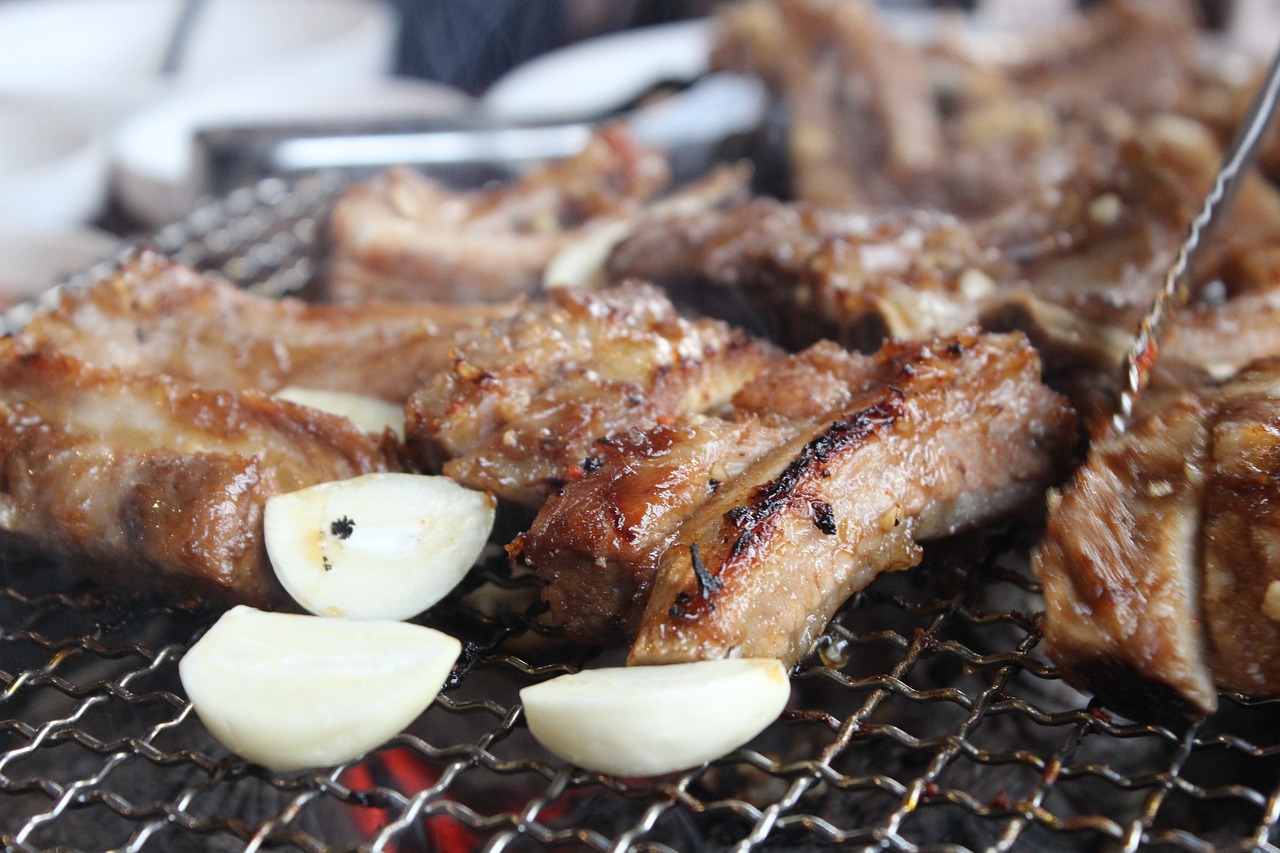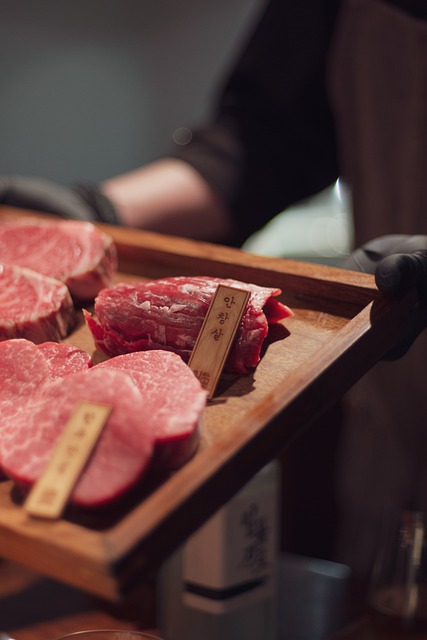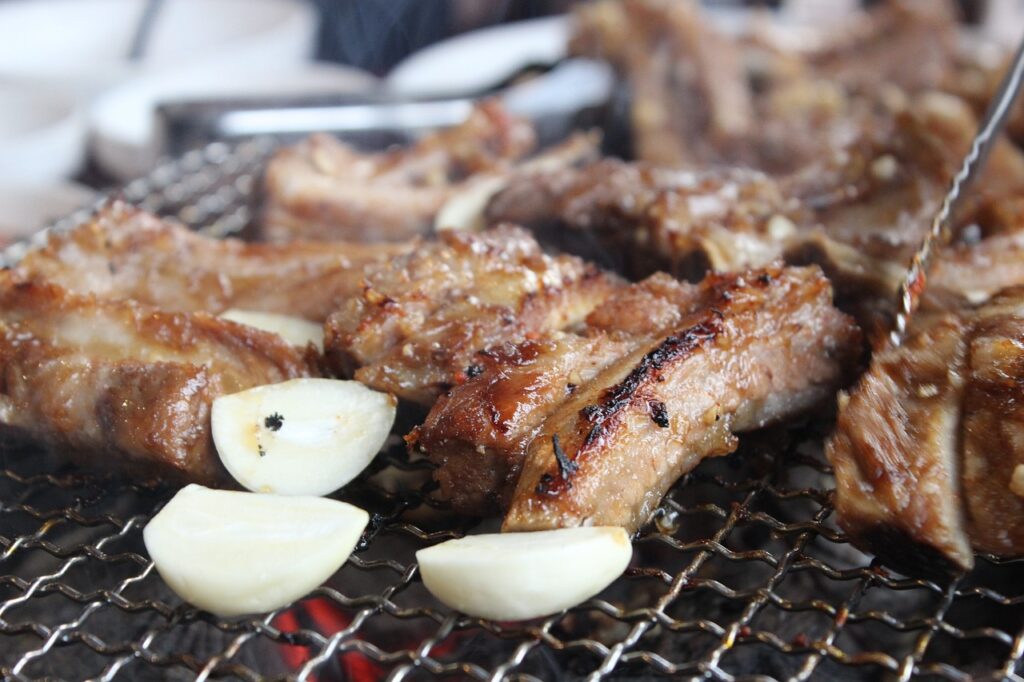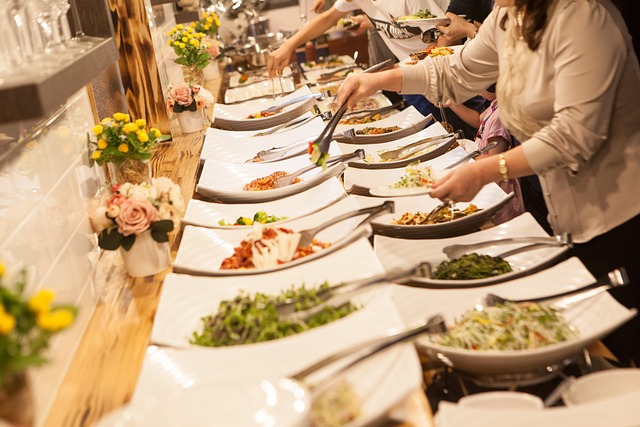Learn all about Korean BBQ – Variety of Meats, Marinades, and Modern Trends in Korean Barbeque, the most popular Korea food. Korean barbecue (Korean BBQ), known for its sizzling grills and communal dining experience, is a culinary journey that goes far beyond the mere act of eating.
In this blog post, we delve into the intricate world of Korean barbecue, uncovering the tantalizing Variety of Meats and Cuts that grace the grill, experiencing the symphony of Distinctive Marinades and Sauces that elevate flavors, and witnessing the ever-evolving Innovations and Modern Trends that have transformed this ancient tradition into a global sensation.
Variety of Meats and Cuts in Korean Barbecue
Korean barbecue offers a gastronomic adventure with its diverse selection of meats. From the succulent marbling of beef in dishes like Bulgogi to the crispy perfection of pork belly in Samgyeopsal, each cut brings its unique texture and taste to the communal table. We’ll explore the nuances of each meat variety, from traditional choices to modern interpretations, showcasing the richness and diversity that define Korean barbecue.
1. Beef
Bulgogi – Thinly Sliced Marinated Beef
Bulgogi, a quintessential Korean barbecue choice, features thinly sliced beef marinated in a mixture of soy sauce, sugar, sesame oil, garlic, and pepper. The result is a sweet and savory delight that grills to perfection, offering a harmonious balance of flavors.
Galbi – Marinated Short Ribs
Galbi, or marinated short ribs, showcases the art of Korean barbecue marinades. The ribs are typically cut across the bone, allowing for a rich marinade penetration. The combination of soy sauce, sugar, garlic, and fruit purees imparts a savory and slightly sweet taste, creating a succulent dining experience.
Chadolbagi – Sliced Brisket
Chadolbagi consists of thinly sliced brisket, allowing for quick grilling and a delightful texture. While not marinated as extensively as other cuts, the emphasis is on the natural beef flavor. It is often enjoyed with dipping sauces like sesame oil mixed with salt and pepper.
2. Pork
Samgyeopsal – Thick Pork Belly Strips
Samgyeopsal, thick slices of pork belly, is a beloved choice in Korean barbecue. Grilled to perfection, it offers a delightful combination of crispy edges and tender, fatty layers. Typically enjoyed with a dipping sauce of salt and pepper or a ssamjang (a mixture of soybean paste, red pepper paste, and sesame oil).
Dwaeji Bulgogi – Marinated Pork
Dwaeji bulgogi brings the bulgogi concept to pork, offering marinated slices of pork that capture the same sweet and savory essence. The marinade often includes soy sauce, garlic, ginger, and sugar, creating a flavorful profile that complements the natural richness of pork.
Jokbal – Braised Pig’s Feet
Jokbal, while not grilled, is a unique pork dish that holds cultural significance. Prepared by braising pig’s feet in a flavorful broth, the meat becomes tender and succulent. It is often enjoyed with a dipping sauce and accompanied by garlic, green onions, and pickled radishes.
3. Chicken
Dak Bulgogi – Marinated Chicken
Dak bulgogi introduces the bulgogi concept to chicken, offering a lighter and leaner option. Marinated in a mixture similar to beef bulgogi, the grilled chicken provides a delightful contrast with its tender texture and nuanced flavors.
Dak Galbi – Spicy Grilled Chicken
Dak galbi features marinated chicken grilled with gochujang (red chili paste) for a spicy kick. Vegetables like cabbage, sweet potatoes, and scallions are often added to the grill, creating a flavorful and dynamic ensemble.
4. Lamb
Lamb Skewers
Inspired by global barbecue influences, some Korean barbecue establishments offer lamb skewers, providing a unique twist to the traditional dining experience. The skewers are often seasoned with a blend of spices and herbs, introducing a fusion element to the meal.
5. Seafood and Other Varieties
Haemul – Seafood
Korean barbecue isn’t limited to land-based proteins. Haemul involves grilling a variety of seafood, including shrimp, squid, and scallops. The seafood is often marinated or brushed with a flavorful sauce before grilling, adding a delightful oceanic dimension to the barbecue spread.
Vegetarian Options
Responding to diverse dietary preferences, some Korean barbecue establishments offer vegetarian options. Mushroom varieties, tofu, and vegetable skewers are seasoned and grilled, providing a flavorful and satisfying experience for non-meat eaters.
Customization and Exploration
Build-Your-Own Experience
The variety of meats and cuts in Korean barbecue allows diners to tailor their experience. From choosing their preferred cuts to experimenting with different marinades and grilling times, the process becomes a personalized culinary adventure.
Exploring Regional Specialties
Different regions in Korea may have their own specialties when it comes to meat cuts and marinades. Exploring regional variations introduces diners to a diverse range of flavors and textures, showcasing the culinary richness of Korean barbecue across the country.
The variety of meats and cuts in Korean barbecue provides a gastronomic journey that caters to diverse preferences. From the succulence of marinated beef to the crispy perfection of pork belly, each cut contributes to the dynamic and communal dining experience that defines Korean barbecue culture.
Distinctive Marinades and Sauces in Korean BBQ
The secret behind the bold and nuanced flavors of Korean barbecue lies in the artistry of marinades and sauces. Gochujang, the fermented red chili paste, weaves its historical roots into the culinary tapestry, while soy-based marinades provide a classic yet versatile base for flavor infusion. Ssamjang, the soybean paste dip, adds a robust touch to the experience. Let’s unravel the complexity of these sauces, understand their historical significance, and appreciate how they contribute to the distinctive taste of Korean barbecue.
1. Gochujang – Fermented Red Chili Paste
History
Gochujang, a cornerstone of Korean barbecue marinades, traces its origins to ancient Korea. The fermentation process involves combining powdered red chili peppers, glutinous rice, fermented soybeans, and salt. This concoction is left to ferment in earthenware pots, creating a paste that embodies the unique umami and spiciness characteristic of gochujang.
Flavor Profile
Gochujang contributes a rich, slightly sweet, and deeply savory flavor to Korean barbecue. Its complex taste, resulting from the fermentation process, adds depth to the marinades and glazes, enhancing the overall dining experience with a signature Korean spice.
2. Soy-Based Marinades
Classic Base for Marination
Soy sauce serves as a classic base for many Korean barbecue marinades. The combination of soy sauce with other ingredients like sesame oil, garlic, ginger, and sugar creates a savory and slightly sweet profile. This versatile base complements various meats, allowing for a range of flavor combinations.
Customization and Creativity
The use of soy-based marinades exemplifies the creativity within Korean barbecue. Depending on the regional preferences or personal tastes, these marinades can be customized, giving each dish a unique twist while still maintaining the essence of traditional Korean flavors.
3. Savory Dipping Sauces
Ssamjang – Soybean Paste Dip
Ssamjang, a thick and savory dipping sauce, is a staple accompaniment in Korean barbecue. Comprising fermented soybean paste, gochujang, sesame oil, garlic, and sometimes sugar, this sauce is both robust and flavorful. It serves as a versatile dip for grilled meats and vegetables, adding an extra layer of umami.
Sesame Oil with Salt and Pepper
A simple yet classic dipping option involves combining sesame oil with salt and pepper. This straightforward mixture enhances the natural flavors of the grilled meats while providing a subtle nuttiness from the sesame oil. It is particularly popular for dipping grilled pork belly (samgyeopsal).
4. Regional Variations
Jeju Black Pork Marinades
In Jeju Island, known for its distinctive black pork, marinades may showcase locally inspired flavors. Citrusy elements like tangerine peel or a hint of island herbs might be incorporated, adding a regional twist to the marinades.
Gangwon Province – Pine Nut Marinades
Gangwon Province is renowned for its pine nut marinades. Crushed pine nuts are mixed with soy sauce and other ingredients, imparting a unique nutty and earthy flavor to the meat. This regional variation reflects the diverse culinary landscape within Korea.
5. Creative Fusion Marinades
International Influences
As Korean cuisine gains global popularity, Korean barbecue chefs sometimes incorporate international flavors into their marinades. Ingredients like honey, balsamic vinegar, or even wine may find their way into the marinade mix, creating innovative fusion dishes that cater to diverse palates.
Fruit-Infused Marinades
Fruit-infused marinades bring a touch of sweetness and acidity to the grilled meats. Pineapple, pear, and apple are commonly used fruits that not only add flavor but also help tenderize the meat. This technique reflects the balance of sweet and savory flavors cherished in Korean barbecue.
6. Health-Conscious Options
Low-Sodium and Lighter Marinades
In response to health-conscious diners, some Korean barbecue establishments offer low-sodium or lighter marinade options. These alternatives cater to those looking for a healthier dining experience while still enjoying the distinct flavors of Korean barbecue.
Gluten-Free and Allergen-Friendly Options
Recognizing dietary preferences and restrictions, chefs may offer gluten-free or allergen-friendly marinades. This inclusivity ensures that individuals with specific dietary needs can still partake in the communal joy of Korean barbecue without compromising their well-being.
The distinctive marinades and sauces in Korean barbecue are a testament to the rich tapestry of Korean flavors. From the fermented depth of gochujang to the savory elegance of soy-based marinades, these elements contribute to the bold and nuanced profile that defines the unique and cherished experience of Korean barbecue.
Innovations and Modern Trends in Korean Barbecue and Korean Food
In recent years, Korean barbecue has undergone a culinary revolution, embracing modern trends and innovations. Barbecue buffets redefine the dining experience, high-quality meats take center stage, and creative fusion dishes blur the boundaries of traditional flavors. Technological advancements bring smart solutions to the table, while sustainability initiatives reflect a growing consciousness. Let’s explore how Korean barbecue has evolved to meet the diverse tastes and preferences of a global audience, making it a culinary art form that continues to capture hearts around the world.
1. Barbecue Buffets
Introduction and Concept
The emergence of barbecue buffets represents a significant innovation in the Korean barbecue scene. Rather than ordering specific dishes, diners have the opportunity to enjoy an all-you-can-eat experience, selecting from a diverse array of meats, side dishes, and accompaniments.
Variety and Customization
Barbecue buffets offer a wide variety of meats, including premium cuts that might not be readily available in traditional à la carte menus. This innovation allows diners to customize their experience, exploring different cuts, marinades, and grilling styles without constraints.
2. High-Quality Meats
Focus on Premium Cuts
Modern Korean barbecue establishments often prioritize the use of high-quality meats. Premium cuts, such as aged beef, wagyu, and specialty pork, are sourced to provide a luxurious and elevated dining experience. This emphasis on quality caters to discerning diners seeking exceptional flavors.
Artisanal and Specialty Offerings
Some establishments go beyond conventional meat choices, offering artisanal and specialty cuts. This trend introduces unique and rare meats, showcasing the culinary creativity of chefs and appealing to those looking for a distinctive and gourmet barbecue experience.
3. Creative Fusion Dishes
Integration of Global Flavors
Modern trends in Korean barbecue include the integration of global flavors into traditional dishes. Chefs experiment with fusion elements, infusing Korean barbecue with international influences. This creative approach introduces innovative marinades, dipping sauces, and side dishes that appeal to diverse palates.
Cross-Cultural Collaborations
Collaborations between Korean barbecue chefs and chefs from other culinary traditions have become a trend. These collaborations result in cross-cultural fusion dishes, combining the essence of Korean barbecue with flavors from other cuisines, creating a harmonious blend that resonates with a global audience.
4. Technological Advancements
Smokeless Grills and Ventilation Systems
Technological advancements have led to the introduction of smokeless grills and improved ventilation systems. These innovations address common concerns associated with traditional barbecue, offering a more comfortable and enjoyable dining experience without the inconvenience of excessive smoke.
Smart Dining Solutions
Some Korean barbecue establishments have embraced smart dining solutions. This includes interactive tabletops with built-in grills, allowing diners to control cooking times and temperatures. Additionally, digital ordering systems streamline the dining process, enhancing overall efficiency.
5. Sustainability Initiatives
Ethical Sourcing and Environmental Consciousness
In response to growing environmental concerns, some modern Korean barbecue establishments focus on ethical sourcing of meats and sustainable practices. This initiative appeals to environmentally conscious diners who seek an eco-friendly dining experience without compromising on flavor or quality.
Plant-Based and Vegetarian Options
Recognizing the increasing demand for plant-based options, some establishments now include vegetarian and vegan choices in their barbecue offerings. Innovative plant-based proteins and meat substitutes are incorporated into the menu, catering to a diverse range of dietary preferences.
6. Culinary Experiences Beyond Meat
Seafood and Grilled Vegetables
Modern Korean barbecue menus extend beyond traditional meat options to include grilled seafood and vegetables. Grilled shrimp, squid, mushrooms, and seasonal vegetables offer a diverse range of flavors, providing options for pescatarians and vegetarians.
Cheese and Specialty Additions
Innovations in Korean barbecue extend to accompaniments and add-ons. Cheese fondue stations, truffle-infused oils, and other specialty additions enhance the overall dining experience, adding layers of richness and complexity to the meal.
7. Culinary Tourism and Global Recognition
Global Popularity and Culinary Tourism
The modernization of Korean barbecue has contributed to its global popularity, turning it into a culinary sensation that attracts enthusiasts worldwide. Culinary tourism thrives as people travel to experience the innovation, diversity, and exceptional quality offered by modern Korean barbecue establishments.
Recognition in International Culinary Circles
Korean barbecue’s modern trends have gained recognition in international culinary circles. The innovation and creativity displayed by chefs have positioned Korean barbecue as a global culinary icon, contributing to the rich tapestry of world gastronomy.
The innovations and modern trends in Korean barbecue reflect a dynamic culinary landscape that embraces quality, creativity, and adaptability. From barbecue buffets to sustainable practices and global fusion dishes, the modernization of Korean barbecue has elevated it beyond a traditional dining experience to a global culinary sensation that continues to captivate food enthusiasts around the world.
As we conclude our journey through the world of Korean barbecue, we find that it is not merely a meal but a cultural phenomenon that has stood the test of time. The Variety of Meats, Distinctive Marinades, and Modern Trends reflect a dynamic and ever-evolving culinary landscape. Whether you’re a traditionalist savoring the classics or an adventurer seeking the latest innovations, Korean barbecue invites you to experience a feast for the senses, embodying the spirit of shared joy and communal dining that has made it a cherished tradition across the globe. If you want to learn more about the history and origins of Korean barbecue, please check out the link.



